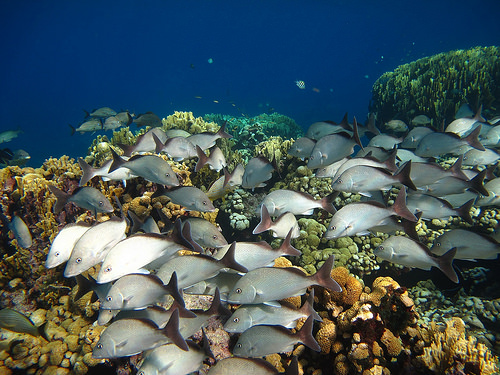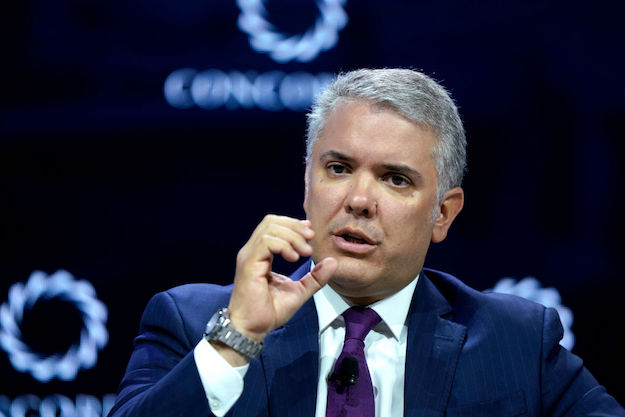April 25, 2014 marked the completion of a very successful scientific endeavor undertaken by more than 20 Colombian institutions committed to broadening the knowledge of the Seaflower Biosphere Reserve and Marine Protected Area (MPA) in the San Andrés, Old Providence and Santa Catalina Archipelago, in the western Caribbean.
View a slideshow of the Seaflower Biosphere Reserve and Marine Protected Area below.
View an expanded version of the slideshow here.
In 2000, UNESCO’s Man and the Biosphere Program (MAB) declared the archipelago the “Seaflower Biosphere Reserve.” To ensure the implementation of this open ocean biosphere reserve, the Corporation for the Sustainable Development of the Archipelago of San Andrés, Old Providence and Santa Catalina (CORALINA), together with the regional environmental authority, community, and local and national institutions developed the Seaflower Marine Protected Area (MPA). In 2005, Colombia’s Ministry of Environment Housing and Territorial Planning announced the creation of the MPA, which is the largest in the Caribbean and one of the largest in the Americas.
The Seaflower Biosphere Reserve and MPA is the result of extensive community participation processes intended to protect the natural environment and the culture of the native people of the archipelago, and to pursue sustainable development goals for all islanders.[1]
Seaflower is known within the region for its exceptionally rich marine biodiversity, which includes more than 407 species of fish, 48 hard corals, 54 soft corals, 130 sponges, 157 birds and many other significant species—including 192 species listed as threatened by the International Union for Conservation of Nature (IUCN). In 2004, the global conservation partnership BirdLife International declared the archipelago an “Important Bird Area” (IBA), and it is part of the western Caribbean biodiversity hotspot.[2]
The IUCN granted the Seaflower MPA the 2010 Countdown Award during the Conference Of the Parties (COP 10) of the Convention on Biological Diversity. In July 2012, the Biosphere Reserve received the Michel Batisse Biosphere Award for its exceptional management. In October 2012, during the Seventh Meeting of the Contracting Parties (COP 7) to the Protocol Concerning Specially Protected Areas and Wildlife (SPAW Protocol) of the Cartagena Convention, the MPA was included in the official list of protected areas in the wider Caribbean.
In 2014, a group of scientists and specialists from CORALINA, the Instituto de Investigaciones Marinas y Costeras José Benito Vives de Andréis (National Marine and Coastal Research Institute—INVEMAR), the Universidad de Bogotá Jorge Tadeo Lozano, the Universidad Nacional de Colombia, the Universidad Javeriana, the Centro de Investigaciones Oceanográficas e Hidrográficas del Caribe (Oceanographic and Hydrographic Research Center—CIOH) and environmental NGOs, among others, conducted a scientific expedition to ensure the sustainable management of this important area. The initiative adds to both local and national environmental conservation efforts, and contributes to the goal of preserving the traditional livelihoods of the archipelago´s Raizal people—the native ethnic community.
The scientists worked for over a month, both ashore and on board the Colombian navy research vessel ARC Providence, to conduct research on oceanographic processes, monitor invasive species, and study water quality, sedimentology, ecological connectivity and integrity, fish biodiversity, and marine fauna—including sharks, cetaceans and coral reefs.
This important portfolio shows the magnitude of the Colombian stakeholders’ efforts, concern and commitment to preserving and ensuring sustainable use of this strategic ecological and cultural heritage. The work will contribute to the ongoing studies to update the Coastal and Marine Ecosystems Map, the Seaflower Biosphere Reserve Atlas and Coral Diversity Studies. But it will also be critical for the development of scientific articles and innovative projects, including research on renewable energy.
The preservation and sustainable development of the Seaflower MPA is of permanent special interest to Colombia’s leading governmental institutions, such as the Ministry of Environment and Sustainable Development, the Colombian Presidential Agency for International Cooperation and the Colombian Ocean Commission—in partnership with research institutes, the local fishing communities, academics, and NGOs.
It is clear that Colombia’s commitment to the Seaflower Biosphere Reserve and MPA is longstanding and has been broadly recognized around the world. This work will continue to ensure the harmonious and sustainable development of this strategic area.
Diversity is the key word for the much-appreciated archipelago that is home to the Seaflower Biosphere Reserve and MPA, and whose natural and ethnic complexities make us proud of being Colombians.
Luis Carlos Villegas is the Colombian ambassador to the United States of America. This article was written in collaboration with the Colombian Navy attaché in Washington DC.
Photos courtesy of Fernando Mancera and Martha Peralta.
[1] Taylor, Elizabeth in http://www.elisleño.com/index.php?option=com_content&view=article&id=3068:a-message-to-the-friends-of-seaflower&catid=41:ambiental&Itemid=83
[2] CORALINA, 2010 Colombia’s Nomination of the Seaflower Marine Protected Area for Inscription on the World Heritage List.








